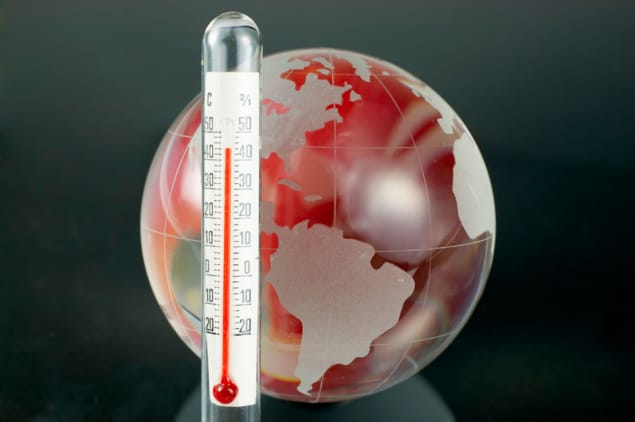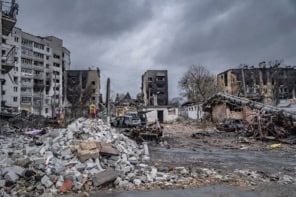
It’s over 120 years since Swedish chemist Svante Arrhenius predicted that burning fossil fuels would enhance Earth’s natural greenhouse effect. Back then Arrhenius thought this warming might be beneficial for future generations. As time has passed it’s become clear that extra carbon dioxide is likely to cause more problems than it solves; by the 1970s concern was growing and in 1975 US-based geochemist Wallace Broecker coined the term “global warming” in his landmark paper “Climatic change: are we on the brink of a pronounced global warming?” But it wasn’t until more than a decade later that a consensus around climate change started to emerge.
The year 1988 proved to be a major turning point. NASA scientist James E Hansen testified to US Congress, reporting a clear cause and effect between excess carbon dioxide and global warming, and predicting that freak weather would be likely to increase over time. Later that same year the Intergovernmental Panel on Climate Change (IPCC) was formed to collate and assess evidence on climate change.
It has shown that human induced climate change is not an opinion but a scientific fact.
Paul Valdes
In the 30 years since the IPCC began, we’ve managed to warm our planet by a further 0.5 °C. Global mean temperatures are now 1 °C warmer than in pre-industrial times, and the rate of warming doubled over the course of the 20th century. A total of 16 of the 17 warmest years on record have occurred since 2000. The statistics are alarming and warming continues apace. So what impact has the IPCC had over its lifetime, and what role should the organization play in the future?
Scientific remit
When first established by the World Meteorological Organization (WMO) and the United Nations Environment Program in 1988, the IPCC’s remit was to provide the world with a clear scientific view on the current state of knowledge in climate change, and the potential environmental and socioeconomic impacts. In this respect the organisation has clearly been successful.
“It has allowed Earth-system scientists to come together in a never-before seen way, to address our current understanding of climate change, its impacts and mitigation strategies,” says Dann Mitchell, climate scientist at the University of Bristol, UK, and contributor to the forthcoming IPCC Special Report on Global Warming of 1.5 °C (SR15). Mitchell’s colleague at the University of Bristol, Paul Valdes, whose work has also been part of IPCC reports, concurs. “Its key achievement has to be showing clear scientific certainty around climate change,” he says. “It has shown that human induced climate change is not an opinion but a scientific fact.”
Any country that’s a member of the United Nations Environment Program or WMO is eligible to join the IPCC; currently 195 countries are members. Crucially, the IPCC does not conduct any research of its own, or monitor climate. Instead the body reviews and assesses the most recent scientific, technical and socioeconomic information. The organization is divided into three Working Groups and a Task Force on Greenhouse Gas Inventories. Working Group I deals with “The Physical Science Basis of Climate Change”, Working Group II with “Climate Change Impacts, Adaptation and Vulnerability”, and Working Group III with “Mitigation of Climate Change”. Meanwhile, the Task Force develops and refines methods for calculating and reporting on national greenhouse gas emissions and removals.
I’m motivated to do this work because it is an amazing experience to meet and work with incredible scientists from around the world, and because I can provide something unique and important to help the world take action on climate change.
Kristie Ebi
It’s a huge undertaking. Thousands of scientists from around the world contribute their expertise and knowledge, all at no cost. Meanwhile, governments participate in the review process and are asked to accept, adopt and approve reports.
“Because scientists are not paid they are able to represent their science and not be bound by their institution, organisation or government, but it is an immense amount of work – up to six months for authors – that often isn’t recognised by universities when considering promotions,” says Kristie Ebi, director of the Center for Health and Global Environment at the University of Washington, US. “I’m motivated to do this work because it is an amazing experience to meet and work with incredible scientists from around the world, and because I can provide something unique and important to help the world take action on climate change.”
Regular tasks
The IPCC’s main output is regular Assessment Reports: chunky volumes that summarize the current state of knowledge. The most recent is the Fifth Assessment Report, published in 2013/14. Its four volumes – on the Physical Science Basis; Impacts, Adaptation and Vulnerability; Mitigation of Climate Change; and the Synthesis Report – were commissioned back in 2008, and represent six years of data assimilation, peer review and rigorous debate.
The IPCC Special Report on Global Warming of 1.5 °C: the why, the what and the how
To date, the ripple from each report has had a significant impact on our understanding and perceptions of climate change. The evidence published in the first IPCC Assessment Report in 1990 underlined the importance of international co-operation to tackle the consequences of climate change, and is credited with triggering the formation of the United Nations Framework Convention on Climate Change (UNFCCC), an international treaty to reduce global warming and cope with the consequences of climate change. The Second Assessment Report of 1995 concluded that the balance of evidence suggests “a discernable human influence” on Earth’s climate, and strongly influenced negotiators in their decision to adopt the Kyoto Protocol extension to the UNFCCC in 1997, with developed nations pledging to reduce emissions by an average of 5% by 2008–12. In 2007 the IPCC was recognized for its work, when together with former US vice president Al Gore the organisation won the Nobel Peace Prize, for “their efforts to build up and disseminate greater knowledge about man-made climate change, and to lay the foundations for the measures that are needed to counteract such change”.
The current format of the IPCC is too cumbersome and needs to change radically… it should make a short report, every two to three years, which focuses on the major updates to the science
Paul Valdes
However, it hasn’t all been plain sailing. Disagreements have flared up over perceptions of scientists using their IPCC credentials to push their own agendas and potentially politicize the science. Meanwhile the 4th Assessment Report, published in 2007, resulted in scandal when a paragraph that projected Himalayan glaciers to disappear by 2035 was found to be incorrect, and the IPCC was hauled over the coals for its use of non-peer reviewed material.
But in the main such problems have been rare, and around the world the findings of the IPCC are held in high regard. “Nowadays, most well-informed unbiased individuals simply accept human-induced climate change based on the overwhelming scientific consensus,” says Mitchell.
Where next?
Which does beg the question “what more can the IPCC do?” Valdes believes that climate science is reaching a similar state of knowledge to that of medical science in the 1970s and 80s, when the link between smoking and health was proven. As a result, he isn’t convinced that climate scientists and the IPCC can do much more to reign in global warming. “I would strongly argue that the barriers for progress are no longer scientific,” he says. “The politically orientated ‘climate sceptics’ will never listen to the science. There will never be a moment when everyone agrees and thus more and better science will, sadly, not help.” Valdes adds that the major job has been done and although there remains a lot of detail to clarify, little of it will alter policy. “Indeed with my palaeoclimate perspective, I think there may well be a limit on the skill of climate predictions,” he says. “At short spatial and temporal scales, climate is chaotic, just like weather, and hence better models will never be able to give precise regional details for 2030, for example.”
That said, climate models can give reliable detail at the country and continent scale, and it is here that Mitchell thinks the IPCC should focus next. “Future IPCC reports could review country-level scientific analyses so that local governments can be better informed,” he says. Meanwhile, Ebi believes there is still much work to be done in understanding the impacts of climate change and assessing adaptation and mitigation strategies. “Most modelling focuses on the physical parameters, but now we need to look at development choices and how they affect vulnerabilities,” she explains. “And we need to investigate the co-benefits of mitigation strategies: often the health benefits of a particular mitigation will pay for the policy.”
Without a doubt the IPCC has helped move the conversation from questioning whether manmade climate change is real, to asking what we can do to prepare and manage the worst consequences. Indeed, those consequences form the basis for much of the science being done now. Currently IPCC scientists are trying to answer the question of what 1.5 °C warming will look and feel like, and what we need to do to keep global warming within these limits. Their Special Report on Global Warming of 1.5 °C, published in October 2018, is in response to the agreement signed at the UNFCCC’s meeting in Paris in 2015. Right now, the stakes couldn’t be higher, and our actions over the coming years will determine what kind of climate Earth has for aeons to come.



